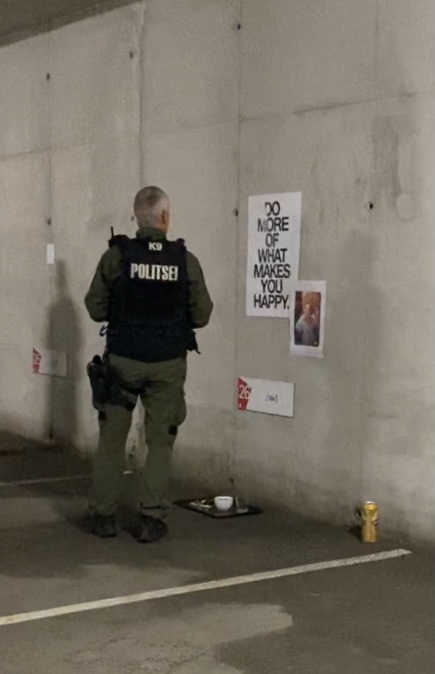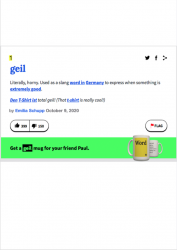
Übergeil* night with friends in a parking lot: making an exhibition as an art student in 2020
A rainy autumn evening in Tallinn: a group of EAA’s students have occupied an empty parking house in the center of the city to exhibit their latest pieces. A pop-up-express exhibition to show some of the fresh works from the nearest surroundings, a quirky experiment to question the possibility of creating something in an extremely short notice, “in a few days and with no certainty about the development of the situation” – almost like a mental reflection of 2020 through the exhibition practice! Sounds fast, sounds spontaneous, sounds like an impulsive fresh breath of young artists, but what was it actually?
Upon arriving at the location, a very exciting environment unfolded itself to the visitor. The first thing one would probably notice is the raw and fragmentary nature of the event, which is totally in its place in the given context. There is always a sense of young rebelliousness in the case of uncoordinated occupation of spaces (the parking space of a typical boring bureau building). This feeling was also escalated by the police officers who showed up in about 15 minutes after the beginning of the exhibition and peacefully investigated the situation. It almost seemed like some kind of anarchistic post-apocalyptic version of the spring exhibition (an annual exhibition of Estonian Artists’ Association held in Tallinn Art Hall, usually exhibiting a large number of their members’ recent works). Obviously it was mainly because this was also a showcase of a quite random selection of artists framed by only one criteria – time.
” There is always a sense of young rebelliousness in the case of uncoordinated occupation of spaces (the parking space of a typical boring bureau building). This feeling was also escalated by the police officers who showed up in about 15 minutes after the beginning of the exhibition and peacefully investigated the situation.”
So what did the artists manage to do in less than a week? Most of the works were quite usual “exercises”: paintings, prints, etc. Some went for simpler installations. The value and idea of the event were probably not the art pieces themselves, but rather the reason why the artists gathered – to make some art together and drink beer on a Friday evening, and it could be felt in the works. What happens if you just have to make “something” to show others and have no institutional responsibility for it? The result is quite fun because if you have to come up with something very quickly, people tend to come up with something simple, with a certain self-irony. But while enjoying this amusing process people start to reflect on the situation and time, and of course themselves. It was noticeable that people created something that simply makes themselves smile.
“The value and idea of the event were probably not the art pieces themselves, but rather the reason why the artists gathered – to make some art together and drink beer on a Friday evening, and it could be felt in the works.”
“Do more of what makes you happy” stated a poster placed on the wall next to a picture of someone guzzling a drink from a huge aquarium, a typical school lunch from university’s cafe, and a big can of Russian beer “для друзей” (rus. “for friends”) standing under it (regardless of if it was accidental or not). This expresses the character of the exhibition quite well. Someone else hung up a series of scribbles inspired by the pandemic, almost like a simple emotional corona-diary. While most of the works were, on the other hand, just some paintings and installations that artists simply enjoyed making (and some of them turned out quite nice), which were not dealing with the topic of the pandemic and/or problems of the current year, there was still some kind of a peculiar feeling of 2020 to the whole exhibition. The small joys, these tiny “lol yeah” moments, and also the quiet hidden insecurities of current “uncertain times” somehow popped up through it. Someone attached a Speedo swimsuit to the column, someone brought a self-portrait photograph of the artist sitting shyly on the floor while hugging themselves, some went for a cool-looking painting, someone else presented a tiny merry rocket made of a burning candle. I imagine that in the next few years all of us will probably be quite fed up with the pandemic-related art pieces, but perhaps this was in some ways one of the few not-so-overwhelming solutions for the reaction to these “uncertain times”.
“Someone attached a Speedo swimsuit to the column, someone brought a self-portrait photograph of the artist sitting shyly on the floor while hugging themselves, some went for a cool-looking painting, someone else presented a tiny merry rocket made of a burning candle.”
As mentioned, the GEIL STUDIO event was not so much about the art itself, but more about the community-building and about the ways of doing things on a short notice. It is amusing to gather and to essentially “fake” a spontaneous exhibition. It’s an interesting exercise to see how we create something in 2020 and to question what we expect from an exhibition, how does this kind of community event work, and most importantly, how do artists and audiences (re)act in this kind of setting. Quite geil!

Participating artists: Tõnis Laurson, Kristina Mirjam Villand, Reigo Nahksepp, Mattias Jürgen Veller, Noa Bar Orian, Tine Simonsen Antonius, Jonas Morgenthaler, Robin Miro Isenmann, Ged Proost, Ott Lemsaar, Kertu Rannula, Erik Merisalu, Johannes Luik, Cristo Madissoo, Florian Siegert, Siim Elmers, Joel Jõevee, Olev Kuma, Egert Tischler, Jelizaveta Shalova, Kati Müüripeal
Curated by: Emilia Schupp and Sidney Lepp.
Anita Kodanik is doing her BA at Art History and Visual Culture in EKA.
